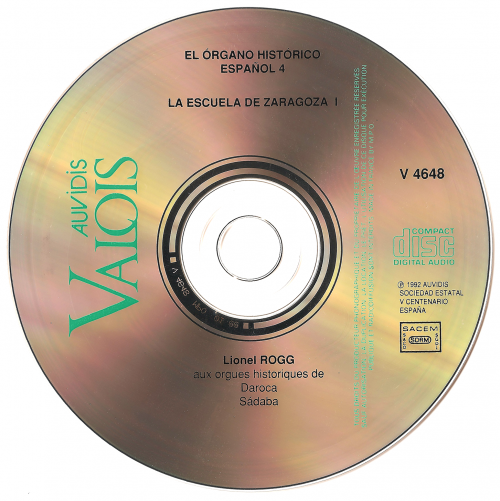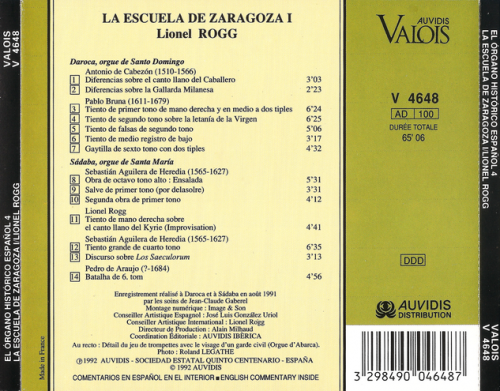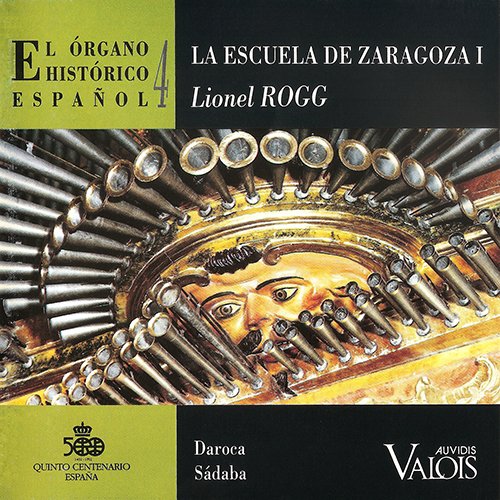
Lionel Rogg - El Órgano Histórico Espanol vol. 4: La Escuela de Zaragoza I (1992)
BAND/ARTIST: Lionel Rogg
- Title: El Órgano Histórico Espanol vol. 4: La Escuela de Zaragoza I
- Year Of Release: 1992
- Label: Auvidis Valois
- Genre: Classical
- Quality: FLAC (tracks+.cue,log,scans)
- Total Time: 1:05:07
- Total Size: 346 MB
- WebSite: Album Preview
Tracklist:
Antonio de Cabezón (1510-1566)
1. Diferencias sobre el canto llano del Caballero
2. Diferencias sobre la Gallarda Milanesa
Pablo Bruna (1611-1679)
3. Tiento de primer tono de mano derecha y en medio a dos tiples
4. Tiento de segundo tono sobre la letanía de la Virgen
5. Tiento de falsas de segundo tono
6. Tiento de medio registro de bajo
7. Gaytilla de sexto tono con dos triples
Sebastián Aguilera de Heredia (1565-1627)
8. Obra de octavo tono alto : Ensalada
9. Salve de primer tono (por delasolre)
10. Segunda obra de primer tono
Lionel Rogg
11. Tiento de mano derecha sobre el canto llano del Kyrie (Improvisation)
Sebastián Aguilera de Heredia (1565-1627)
12. Tiento grande de cuarto tono
13. Discurso sobre Los Saeculorum
Pedro de Araujo (?-1684)
14. Batalha de 6. tom


Antonio de Cabezón (1510-1566)
1. Diferencias sobre el canto llano del Caballero
2. Diferencias sobre la Gallarda Milanesa
Pablo Bruna (1611-1679)
3. Tiento de primer tono de mano derecha y en medio a dos tiples
4. Tiento de segundo tono sobre la letanía de la Virgen
5. Tiento de falsas de segundo tono
6. Tiento de medio registro de bajo
7. Gaytilla de sexto tono con dos triples
Sebastián Aguilera de Heredia (1565-1627)
8. Obra de octavo tono alto : Ensalada
9. Salve de primer tono (por delasolre)
10. Segunda obra de primer tono
Lionel Rogg
11. Tiento de mano derecha sobre el canto llano del Kyrie (Improvisation)
Sebastián Aguilera de Heredia (1565-1627)
12. Tiento grande de cuarto tono
13. Discurso sobre Los Saeculorum
Pedro de Araujo (?-1684)
14. Batalha de 6. tom
“The historical Spanish organ” : under this apparently simple title, how many events, how many
relizations and what music! To dedicate a series of ten compact discs to this idea is an exciting
venture, but it is also a challenge...
An undertaking like this has been made possible thanks to the inexhaustible energy of its
instigators, the harmonious collaboration of the organists, the availability of the organ
builders, the competence of the sound technicians and the interests of the persons responsible
for the churches.
As far as the music is concerned, it was above all a matter of taking a census of the most
outstanding historical instruments still in use. This task was especially entrusted to José Luis
González Uriol, from Zaragoza. As much as possible we have tried to represent every part of Spain,
although the most interesting organs are evidently not distributed in a regular manner throughout
the country. Next we had the pleasant task of choosing the performers, who were charged with
getting the post out of the instruments. It was logical to turn to three of the Spanish organists
who have contributed most to the realization of the instrument’s artistic heritage : Montserrat
Torrent, José Luis González Uriol and Josep Mas i Bonet.
As one of the objectives of the “Fifth Centenary” is precisely to tighten the cultural ties between
Spain and America, we felt it was desirable to associate two or three organists from across the
Atlantic with the project. Two young performers make the art of organ playing shine in the
countries of Latin America : Elisa Freixo from Brazil and Cristina Garcia Benegas from Uruguay.
And in North America we selected Kimberly Marshall, a specialist in the Gothic and Renaissance
organ. In Europe, among the organists who have contributed to make the Spanish organ known and
appreciated, the names Francis Chapelet and Guy Bovet stand out. Finally, bearing in mind the
relation between Spain and Flanders during the XVIth and XVIIth centuries, it seemed appropriate
to us to include a Belgian organist, Bernard Foccroule, in this project.
The selection has also been conditioned by the respective personalities of the ten performers,
each of which had to be ascribed one or two instruments and a coherent part of the repertory.
This proved to be the main difficulty of this programme. Ideally, we would entrust the recording
of Cabezon’s works, to a specialist of Cabezón playing Cabezon’s organ, with the registers of the
period, and then repeat the same operation in the ten discs. But history does not allow itself to
be recreated so easily. Often the instruments which had been played by the grat organists had
disappeared, and those remaining were preserved because of their location in a small village,
and had often suffered modifications. Thus it was practically impossible to interpret a composer’s
work in conditions of absolute historical fidelity... but does it matter ?
For these reasons we had to opt for a more subtle solution to the complex equation “instruments-
repertory-performers”, and a certain flexibility has undoubtedly enabled us to present a more
vivid panorama of this rich heritage. It must be said, however, that the spirit and colour of the
historical Spanish organ in its entirety has been preserved, and that the recent restorations are
evidence of a respect which unfortunately has not always been demonstrated in other European
countries. Each of the ten discs in the collection has been dedicated to a different composer
(Cabezón, Correa de Arauxo, Cabanilles), to a regional school, or even to the splendour of an
instrument particularly rich in possibilities.
Because of its participation in the highest life of the spirit and its deep roots in daily life,
is not the organ the privileged witness of the culture of an entire people ? We hope that this
recording may contribute to making known and loved this irreplaceable expression of the Spanish
soul.
relizations and what music! To dedicate a series of ten compact discs to this idea is an exciting
venture, but it is also a challenge...
An undertaking like this has been made possible thanks to the inexhaustible energy of its
instigators, the harmonious collaboration of the organists, the availability of the organ
builders, the competence of the sound technicians and the interests of the persons responsible
for the churches.
As far as the music is concerned, it was above all a matter of taking a census of the most
outstanding historical instruments still in use. This task was especially entrusted to José Luis
González Uriol, from Zaragoza. As much as possible we have tried to represent every part of Spain,
although the most interesting organs are evidently not distributed in a regular manner throughout
the country. Next we had the pleasant task of choosing the performers, who were charged with
getting the post out of the instruments. It was logical to turn to three of the Spanish organists
who have contributed most to the realization of the instrument’s artistic heritage : Montserrat
Torrent, José Luis González Uriol and Josep Mas i Bonet.
As one of the objectives of the “Fifth Centenary” is precisely to tighten the cultural ties between
Spain and America, we felt it was desirable to associate two or three organists from across the
Atlantic with the project. Two young performers make the art of organ playing shine in the
countries of Latin America : Elisa Freixo from Brazil and Cristina Garcia Benegas from Uruguay.
And in North America we selected Kimberly Marshall, a specialist in the Gothic and Renaissance
organ. In Europe, among the organists who have contributed to make the Spanish organ known and
appreciated, the names Francis Chapelet and Guy Bovet stand out. Finally, bearing in mind the
relation between Spain and Flanders during the XVIth and XVIIth centuries, it seemed appropriate
to us to include a Belgian organist, Bernard Foccroule, in this project.
The selection has also been conditioned by the respective personalities of the ten performers,
each of which had to be ascribed one or two instruments and a coherent part of the repertory.
This proved to be the main difficulty of this programme. Ideally, we would entrust the recording
of Cabezon’s works, to a specialist of Cabezón playing Cabezon’s organ, with the registers of the
period, and then repeat the same operation in the ten discs. But history does not allow itself to
be recreated so easily. Often the instruments which had been played by the grat organists had
disappeared, and those remaining were preserved because of their location in a small village,
and had often suffered modifications. Thus it was practically impossible to interpret a composer’s
work in conditions of absolute historical fidelity... but does it matter ?
For these reasons we had to opt for a more subtle solution to the complex equation “instruments-
repertory-performers”, and a certain flexibility has undoubtedly enabled us to present a more
vivid panorama of this rich heritage. It must be said, however, that the spirit and colour of the
historical Spanish organ in its entirety has been preserved, and that the recent restorations are
evidence of a respect which unfortunately has not always been demonstrated in other European
countries. Each of the ten discs in the collection has been dedicated to a different composer
(Cabezón, Correa de Arauxo, Cabanilles), to a regional school, or even to the splendour of an
instrument particularly rich in possibilities.
Because of its participation in the highest life of the spirit and its deep roots in daily life,
is not the organ the privileged witness of the culture of an entire people ? We hope that this
recording may contribute to making known and loved this irreplaceable expression of the Spanish
soul.


Download Link Isra.Cloud
Lionel Rogg - El Órgano Histórico Espanol vol. 4: La Escuela de Zaragoza I (1992)
My blog
Lionel Rogg - El Órgano Histórico Espanol vol. 4: La Escuela de Zaragoza I (1992)
My blog
Classical | FLAC / APE | CD-Rip
As a ISRA.CLOUD's PREMIUM member you will have the following benefits:
- Unlimited high speed downloads
- Download directly without waiting time
- Unlimited parallel downloads
- Support for download accelerators
- No advertising
- Resume broken downloads


